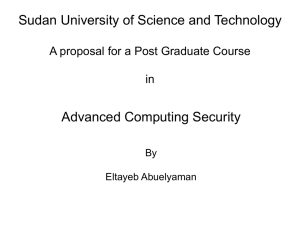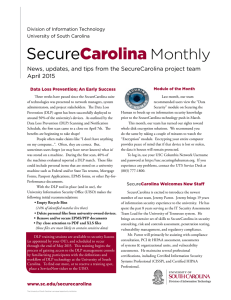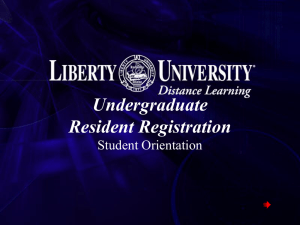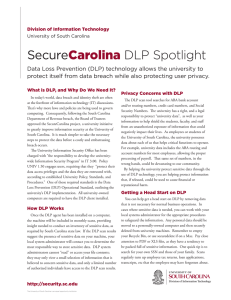3D Web Agents in Distributed Logic Programming
advertisement
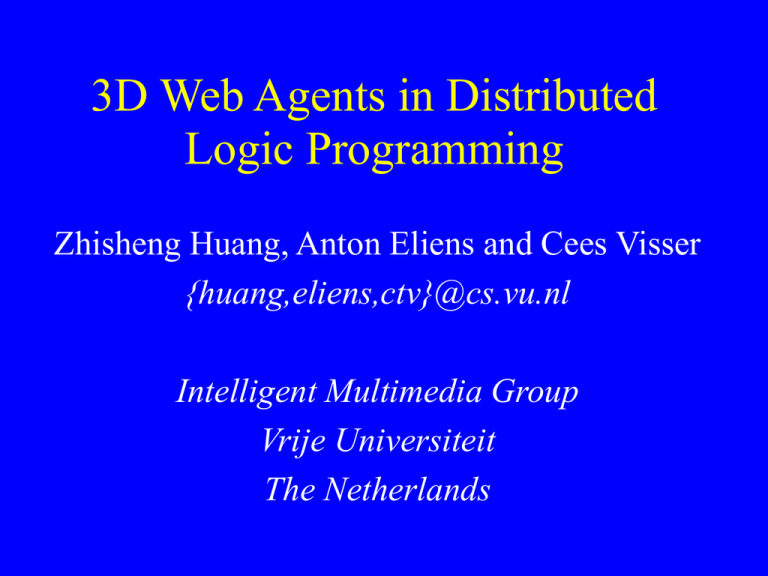
3D Web Agents in Distributed
Logic Programming
Zhisheng Huang, Anton Eliens and Cees Visser
{huang,eliens,ctv}@cs.vu.nl
Intelligent Multimedia Group
Vrije Universiteit
The Netherlands
3D Web Agents are intelligent agents whose
avatars can interact with users via Web
browsers. These Web-based 3D avatars are
usually constructed by means of the Virtual
Reality Modeling Language VRML.
Outline of This Talk
1 Main Features of 3D Web Agents
2 Requirements of Programming/Specification
Languages for 3D Web Agents
3 Distributed Logic Programming Language (DLP)
for 3D Web Agents
4 Examples
4.1 VRML-based Multi-User Soccer Game
4.2 Facial Animation in DLP
5 Conclusions
Main Features of 3D Web Agents
•Cross-Platform: Accessible for any Web browser with a
VRML viewer;
•Mobility: Accessible from anywhere over the Web;
•Reactivity in Real Time: Can react in real time. No heavy
rendering delay;
•Flexibility: Rule-based knowledge representation makes the
changes of behaviors rather easy. Need no re-programming.
Requirements of General
Programming/Specification
Languages for 3D Web Agents
•
•
•
•
VRML EAI support, like Java
Multi-threaded control
Object-Oriented
Declarative language: rule-based
knowledge representation/specification,
like Prolog
• Distributed communication/computation
capabilities
Architecture of Web Agents:
Extended BDI Model
Desire
Intention
Belief
effectors
sensors
Sensor/Effector Primitives
for 3D Web Agents
getPosition(Object, X, Y, Z)
setPosition(Object, X, Y, Z)
getRotation(Object, X, Y, Z, R)
setRotation(Object, X, Y, Z, R)
getViewpointPosition(Agent, X, Y, Z)
setViewpointPosition(Agent, X, Y, Z)
getViewpointOrientation(Agent, X, Y, Z, R)
setViewpointOrientation(Agent, X, Y, Z, R)
Distributed Logic Programming
DLP
Distributed logic programming [Eliens:1992]
combines logic programming, object-oriented
programming and parallelism.
DLP has been extended with a 3D VRML
Client Interface Library, which includes
the sensor/effector primitives for 3D web
agents.
Main Features of DLP for 3D
Web Agents
• Multi-threaded Language: modeling of independent
intra or inter agent activities;
• Distribution: high-level TCP/IP based facilities for
distributed communication, thus DLP can be used to
build virtual multi-user communities;
• High-level communication Protocols: support for
Agent Communication Languages (ACL);
• Declarative Language: rule-based knowledge
representation
Benchmark Example:
Soccer games on the Web
Http://wasp.cs.vu.nl/wasp/
Features of VRML-based Soccer
Games
•
•
•
•
•
•
Multi-Agent Systems
Multi-User Systems
Reactivity
Cooperation / Competition
Dynamic Environments
Distributed Communication
Cognitive loop:
sensing-thinking-acting
thinking
sensing
Belief
Intention
Desire
acting
Cognitive model of soccer game
Action Specification in Agent’s
Knowledge-Bases
• look-at-ball
• run-to-ball
• shooting
• passing
• move-around
• run-and-trace
• near-ball-then-kick
• …...
DLP code example:
the action “Look-at-ball”
look_at_ball(Player,Ball) :getPosition(Player, X,_,Z),
getPosition(Ball, X1,_,Z1),
X =\= X1,
!,
R is atan((Z-Z1)/(X-X1)) sign(X-X1)*1.57,
setRotation(Player,0.0, 1.0,
0.0, R).
DLP code example:
the action “find-how-to-react”
findHowtoReact(Agent, Ball, shooting):getPosition(Agent,X,Y,Z),
getPosition(Ball, Xb,Yb,Zb),
gatePosition(Agent,Xg,Yg,Zg),
distance(X,Y,Z,Xb,Yb,Zb,Distb),
distance(X,Y,Z,Xg,Yg,Zg,Distg),
Distb =< kickableDistance
Distg =< kickableGoalDistance.
Agent Communication Language
•agent communication languages (ACL) are used
to serve as a high-level communication
facility.
•KQML and FIPA ACL which are based on speech
act theory are popular agent communication
languages.
• A message in ACL usually consists of a
communicative act, a sender name, a list of
recipients, and additional content.
• Communicative acts like 'tell', 'ask', and
'reply', are used to identify the
communication actions which may change the
mental attitudes of the agents.
VRML-based client-server
Architecture
server
VRML EAI
VRML EAI
VRML EAI
browser
browser
browser
client
client
client
Shared Object
•A shared object is an object whose state and behavior
are to be synchronized across multiple clients
3D agent-based virtual
communities
•Virtual environments with embedded agents:
autonomous agents are participants in virtual
communities.
•Virtual environments supported by ACL
communication: Agent communication
languages are designed to provide a high-level
communication facility. The communication
between the agents can be used for the realization
of shared objects in virtual worlds.
PAMELA as Presentation Agent
Facial Animation
H-anim 1.1 Compliant Avatars
The intelligent agent avatars are designed
to be H-anim 1.1 compliant, based on the
specification for a standard humanoid
proposed by Humanoid Animation
Working Group.
DLP code example:
Eyebrow Up and Lip Move
eyebrowUp_lipMove(Times,Interval, Range) :getPosition(eyebrowRight, X1,Y1,Z1),
getPosition(eyebrowLeft, X2,Y2,Z2),
eyebrow_up(eyebrowRight, 0.01),
eyebrow_up(eyebrowLeft, 0.01),
lipMove(lowerlip,Times,Interval,Range),
setPosition(eyebrowRight, X1,Y1,Z1),
setPosition(eyebrowLeft, X2,Y2,Z2).
Conclusions
• A technology for 3D web agents needs a general
programming / specification language which
merges aspects of object-oriented languages,
web3D- oriented languages, and declarative
languages.
• The distributed logic programming language
DLP is a general programming/specification
language for 3D web agents.
• DLP is a convenient tool for the implementation
of 3D web agents.
